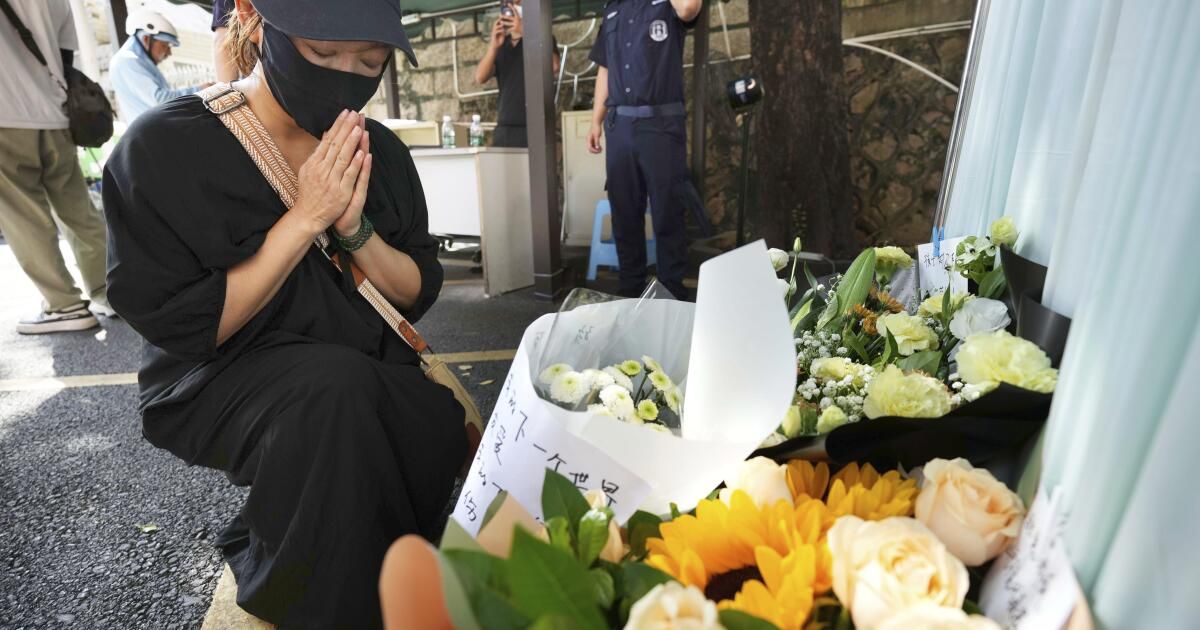A deadly knife attack on a Japanese schoolboy in China has fueled friction between the two countries and raised security concerns at a time when China is trying to attract foreigners to work and travel.
The 10-year-old student was stabbed to death by a 44-year-old man outside the gates of a Japanese school in Shenzhen last week.
Chinese authorities have not revealed any motive for the attack.
Japanese authorities are seeking more details of the investigation and expressing concern for the safety of their citizens there. In 2022, there were 102,066 Japanese citizens living in China, according to government data, close to a 20-year low.
“We strongly demand that the Chinese side explain the facts,” Prime Minister Fumio Kishida was quoted as saying last week by Japanese media. “I cannot help but feel deep regret. It was an extremely cowardly crime and a serious incident.”
Some Japanese companies, including Panasonic, have offered to relocate their China-based employees back home, according to media reports.
The Sept. 18 attack, which occurred on the anniversary of Japan's invasion of Manchuria, now northeast China, follows a similar attack in June in which a man in his 50s attacked a Japanese woman and her preschool-aged son with a knife as they waited for a school bus in the eastern city of Suzhou. A Chinese woman who intervened to prevent the attacker from boarding the bus later died of her injuries.
China's Foreign Ministry has called both knife attacks “isolated incidents,” but the acts of aggression have aggravated growing mistrust between Japan and China, which have clashed over everything from regional defense to a controversial plan to release treated wastewater from Japan's decommissioned Fukushima nuclear plant last year.
On Monday, Japanese Foreign Minister Yoko Kamikawa met with her Chinese counterpart Wang Yi in New York and said she had urged China to ensure the safety of Japanese citizens in the country. Japan plans to spend about $300,000 to improve security at Japanese schools there.
Kamikawa also called on Beijing to crack down on anti-Japanese sentiment online.
Major Chinese tech companies have announced efforts to curb inflammatory rhetoric on social media platforms. On Saturday, after the latest attack, popular short-video app Kuaishou (similar to TikTok) said it had banned or suspended around 90 accounts for spreading hate speech.
On Tuesday, a heated debate over the tensions broke out on Weibo, a microblogging app similar to X. One certified account with 3 million followers took aim at Japan for growing hostility toward the Chinese people: “According to surveys, in recent years up to 93% of the Japanese public expresses dislike for China. So who exactly is playing the ‘hate education’ game?”
An annual government survey conducted last fall showed that 86.7 percent of Japanese “feel unfriendly” toward China, a record high dating back to 1978, Kyodo News reported.
Fear of detention and public anger have deterred foreigners, including Japanese citizens, from returning to China following the COVID-19 pandemic, despite government efforts to project an open and friendly image. Four American instructors were also stabbed in June during a visit to China’s northeastern Jilin province.
Tomoko Ako, a professor of Chinese studies at the University of Tokyo, doubts that increased monitoring of online discussions will reassure foreigners about their safety in China. She says her university is considering cancelling a regular exchange program for her Chinese class.
“In recent years, fewer and fewer people are enrolling,” he says. “Many students are afraid.”
In a statement on Monday, Chinese Vice Foreign Minister Sun Weidong said China and Japan were working toward a constructive and stable relationship, and expressed regret over the death of the Japanese schoolboy.
“China upholds the rule of law and has taken and will continue to take effective measures to protect the safety of all foreigners in China,” the statement said.
Wu is a Times special correspondent.












